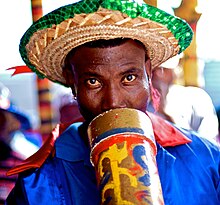Rara (music)
Rara is a kind of festival music coming out of the Caribbean state of Haiti stems and mainly during the Easter Holy Week in street parades is played. The main components of the music are cylindrical bamboo or metal trumpets ( vaksen ), which are often recycled from coffee cans . Also find drums , maracas , Güiras , Gueiros and metal bells use. The vaksen are used to play repeating rhythms, which are also played with a stick while they are being blown into. For more recent moves, conventional trumpets and saxophones are also used. The music style is based to a large extent on the culture of the African immigrants, but has elements of the Taíno - Indians , such as the use of the Güiros and maracas.
Rara songs are performed exclusively in Haitian and celebrate the African roots of Afro-Haitians. Voodoo is often practiced during the procession . The style of music also found its way to the Dominican Republic , where it is now an important part of the Afro-Dominican music scene and is known colloquially as gagá . In the Dominican Republic, the music is often played by the Afro-Dominican population as a cultural tribute to their African ancestors, similar to Haiti.
Rara song lyrics are usually about social injustice, political oppression and poverty. In the past, this has resulted in Rara groups and musicians being banned from performing or being exiled , such as folk singer Manno Charlemagne , who returned to Port-au-Prince in the 1990s and was elected mayor of the capital of Haiti. Rara is also often used for political purposes in Haiti, with politicians having their own songs composed to praise them and their campaign.
Rara appearances often take place during street parades , which are accompanied by staff turners . The most important time for this is between Ash Wednesday and Holy Week. These rare festivals probably originated during colonialism and its slavery . There is evidence that African and Afro- Creole slaves in the French colony of Saint Domingue with drums and other instruments on Easter Sunday for parade teased. Furthermore, groups of maroons with drums, horns and singers, similar to Rara music, should have marched.
Since the 1990s, Haitian Americans have performed rare pieces in New York's Central and Prospect Park on Sundays during the summer months .
literature
- Elizabeth McAlister: Rara! Vodou, Power, and Performance in Haiti and Its Diaspora . University of California Press, Berkeley 2002, ISBN 0-520-22823-5 (English, 257 pages).
Individual evidence
- ↑ Peter Manuel, Kenneth Bilby, Michael Largey: Caribbean Currents: Caribbean Music from Rumba to Reggae . Temple University Press, Philadelphia 2006, ISBN 1-59213-462-9 , pp. 156 (English, full text in Google Book Search [accessed June 8, 2017]).
- ^ John Shepherd, David Horn: Bloomsbury Encyclopedia of Popular Music of the World, Volume 9: Genres: Caribbean and Latin America . 1st edition. Bloomsbury Academic, London 2014, ISBN 978-1-4411-4197-2 , pp. 447 (English).
- ^ Elizabeth McAlister: Rara Festivals in Haiti and New York. In: rara.wesleyan.edu. Wesleyan University , archived from the original on January 17, 2016 ; accessed on August 25, 2017 .
- ^ Kareem Fahim: After Tough Year, New York's Haitians Gather. In: The New York Times . The New York Times Company, September 6, 2010, accessed August 25, 2017 .

